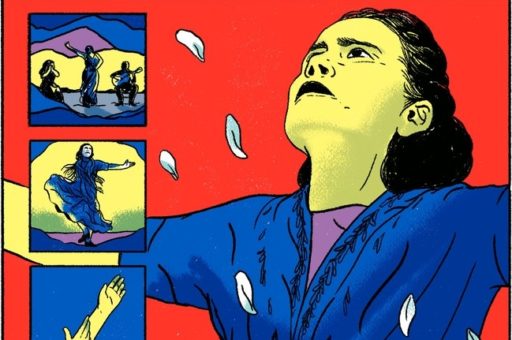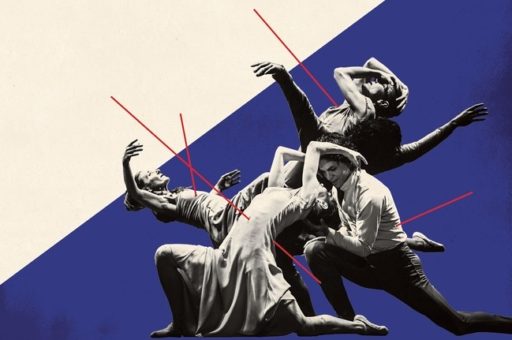In recent weeks, the vinyl surface known as marley, which covers the floor of many dance studios and stages, has been cut into pieces and shipped around the world to professional dancers exiled to their homes. I have been watching some of these dancers, standing on these outposts of abandoned theatres, in their kitchens and living rooms, as they take their daily ballet class on Zoom, Instagram, YouTube. They are doing it for one another and for themselves: class preserves the body, but above all it tames the mind. It is logical, rigorous; there are rules to be followed, tasks to perform, ideals to achieve. It breaks things down, ordering the limbs in repetitive exercises that every dancer knows by heart, like a daily prayer.
Ordinarily, dancers begin class slowly, holding a barre or the back of a chair for support, until they feel their legs, feet, and spine and find their “center”—center of body, of gravity, of mind. As brain and body begin to cohere, dancers move to the center of the studio—space mirroring body—for more expansive movements, like turns and leaps. Class holds a reassuring promise: work hard and you will improve. At its best, it can feel like a purification. As a former dancer, I have never felt my body so lightened, steadied, and purged of anxiety as I have at the end of class.
Dancers spend their lives digging inside their bodies, searching for hidden reservoirs of emotion. That’s part of what class is about—but it is rarely, as it is now, solitary work. Taken alone, class can become mechanical. An accomplished teacher draws on centuries of knowledge and also on close observation—of mood, aura, carriage, the stubbornness in a joint of the foot, the fear lodged in a knotted muscle—to touch just the right spot to make the dancer’s whole skeleton realign. A hand between the shoulder blades or a finger pressed into a palm can suddenly reveal a secret or unexpected source of expression—“That’s it!”—and everyone present sees the change. You can’t access that kind of revelation by yourself or on Zoom. And, since most kitchens and living rooms are without much of a “center” to move into, many dancers find themselves confined to the barre, holding on, in their most dependent and vulnerable state. Watching their lonely devotion to the basics of their craft—bending the knees or arching the back—we feel their grit and heartbreak. Their class is truncated, a communal rite cut down to a startlingly raw solo form.
Dancers are also performing online. You can watch Misty Copeland and a group of ballerinas dancing Michel Fokine’s elegiac “Dying Swan” in their homes. You can see stars of the Paris Opera Ballet passing steps like footballs, punting from one dancer to the next, kitchen to patio, to Prokofiev’s “Romeo and Juliet.” More fun, the Australian Ballet’s “Wilis in Corps-en-tine (A ‘Giselle’ Skit),” or, more interesting and less sentimental, Mark Morris’s new video dances, choreographed on Zoom. One is titled “Lonely Waltz,” another “Lonely Tango.”
George Balanchine rightly said that watching dance on TV was like reading about a murder in a newspaper—a poor approximation of the terror of the real event. And, for all its offerings, the new online dance world feels cramped and constrained. Dancers are a kind of urban wildlife, and as they crop their bodies to Zoom squares we can almost feel their horizons shrinking. They can, too. Watch a dancer in Valencia, taking out his garbage, break into an aching, full-bodied solo for a cheering audience hanging from windows, before bowing back into his quarantine pen. These outpourings are touching, desperate, and, ultimately, a kind of requiem: Remember us!
In New York, dance will not be the same. Much has been lost, but there was a surfeit of bling, especially in the ballet world. Less could really be more. The basic structures—where and how dance is performed—are not all that will be questioned. The virus has already changed our sense of our bodies, which seem suddenly mysterious, weakly defended. Our sense of time, the dancer’s tool and trade, has also been jarringly disrupted, but in this, at least, dancers are prepared. Living in the present is part of the training. “What’s the matter with now?” Balanchine famously said. “You might be dead tomorrow.”
In this moment of collective grief, I am reminded that dance has always been death’s close companion, a way of mourning since at least the Middle Ages. During the Black Death, artists depicted the Dance of Death, with skeletons gleefully accompanying rich and poor alike to the grave. In the early nineteen-hundreds, as a child in Petrograd, Balanchine lived through war and revolution, suffered from malnutrition, and saw the piles of bodies and mass graves that were populating the city. Few choreographers were more preoccupied with death and grief, or brought a more erotic and heightened sense of life and joy to the stage.
The First World War also produced Mary Wigman, a founder of German Expressionist dance and an influence on early American modern dance. Deeply affected by her work with crippled and traumatized veterans, including her brother, and by her own suffering from tuberculosis, she developed a style of movement that was weighted and contracted from the gut and back. Her solo dances, performed barefoot, had heavy overtones of piety and redemption, with titles such as “Death” and “Sacrifice.” Later in the century, anguish over the bombing of Hiroshima and Nagasaki produced its very own dance form in the ashen bodies of Butoh. And the aids epidemic gave us, among other works, Bill T. Jones’s “D-Man in the Waters.”
Today, we have Jamar Roberts. Last fall, for the Alvin Ailey company, he made “Ode,” a dance in response to gun violence. Rather than stricken bodies or the sound of gunfire, it features six elegant black men, bare-chested and wearing simple pants, set against a spray of colorful flowers. Their bodies appear almost ornate, and their movement, to the at times harsh free jazz of Don Pullen’s “Suite (Sweet) Malcolm (Part 1: Memories and Gunshots),” from 1975, has a stubborn poise. At the end, five of the dancers fuse together in a kind of human chain, not just hand to hand but body to body—“one long arm,” Roberts has called it—and this one long arm lowers a lifeless man to the ground in a heap. As they fade off the stage, he is left there, alone, where he began, beneath the flowers. The dance is not a lament, not the blues, but a more gentle act, a wreath laid on a grave.
At the end of May, in a commission from the Guggenheim’s “Works & Process” series, Roberts produced an extraordinary five-minute dance titled “Cooped.” He choreographed, designed, directed, performed, and shot (on an iPad) this “fever dream,” alone, in a basement, surrounded by shadows that seem to close in on him—an effect ingeniously created by a floor lamp and a flashlight. The tense music was composed, arranged, and performed (remotely) by David Watson (bagpipes) and Tony Buck (drums).
At the opening of the dance, Roberts comes into view seemingly hanging upside down from the ceiling. The image is shocking, but he is glistening and beautiful, swaying as his elbows sweep the floor. His arms cross over his head and he uses them like legs to push off into a suspended state, then he quickly reattaches, insect-like, to another ceiling or surface. In this Kafkaesque space, gravity and weight do not operate in normal ways. Nor does his body. At one point, he shudders inside, quaking to the edge of his human form; at other times he is quieted but weird, his fingers moving anxiously across his torso. By the end, he is some kind of creature in an awkwardly collapsed backbend, supported precariously by the balls of his feet and the crown of his head. As his long arm reaches across his body, his hand grasps his chin and turns his face abruptly from the camera. ♦




